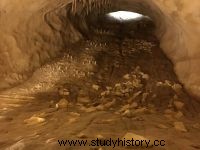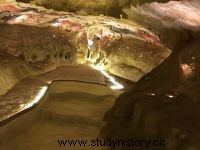Simon Coencas, last survivor of the four teenagers "discoverers" of the Lascaux cave in 1940, a world-famous masterpiece of parietal art, died at the age of 93.

Simon Coencas, one of the four teenagers who discovered the Lascaux cave in 1940, on November 18, 2016 in Paris.
As the last "discoverer" of the Lascaux cave disappears, we invite you to reread the article by Bernadette Arnaud, great reporter at Sciences et Avenir :"Lascaux, the sanctuary hill" was originally published in issue 838 of Sciences et Avenir.
Simon Coencas notably returned to the Dordogne at the end of 2016 for the inauguration, alongside President François Hollande, of the International Center for Parietal Art - more commonly known as "Lascaux 4" - an identical full replica of Lascaux. As a teenager, he was part of the group of four young people who had discovered the famous Dordogne cave. He died in Paris where he resided, this Sunday, February 2, 2020, told AFP, Thierry Félix, historian specializing in Lascaux and close to Mr. Coencas, who was informed of the death by the family of the nonagenarian.
Lascaux, "Sistine Chapel of Prehistory"
On September 12, 1940, with three friends aged 18 to 15, Marcel Ravidat, Georges Agniel and Jacques Marsal, Simon Coencas, 13 at the time, had discovered the Lascaux cave, by "exploring a hole" hiding a cavity, on the wooded hill overlooking the village of Montignac (Dordogne). The “hole” would turn out to be an ornate cave, paintings made about 18,000 years ago and classified since 1979 as a UNESCO World Heritage Site, a masterpiece often described as "Sistine Chapel of Prehistory" .
The origin of the discovery was Marcel Ravidat's dog:the so-called Robot had stopped in front of a deep hole on the hill of Lascaux. The young man had returned to explore it four days later, falling on the way to three young people from the area who decided to support him. "With my little band, we were looking for the underground of the old castle nearby. We hoped to find a treasure. We found one but not the one we thought", said Simon Coencas at the end of 2016, in an interview with AFP. Lighted by a pigeon lamp, they progressed little by little "and at one point we came across the hall of the bulls" , he said then. "A marvel. So big, so impressive (...) We were terrified. We said to ourselves it is not possible to discover such a thing!".The four friends initially decided to keep the secret, "but in the end everyone chatted away". The local teacher, keen on archeology, was skeptical at first but when he went to see the cave, "he was amazed" . The archaeological community was alerted, and Abbé Breuil, a renowned prehistorian and professor at the Collège de France, visited the cave on September 21.
For the anniversary of Lascaux, a visit to the International Center for Parietal ArtMontignac's friends
Of the other three "discoverers" de Lascaux, Jacques Marsal had died in 1989, Marcel Ravidat in 1995, and Georges Agniel in 2012. MM. Agniel, Coencas and Ravidat, had received in 1991 the medal of knight of the National Order of Merit. Simon Coencas, whose parents were Jews of Greek origin established in Paris, lived in 1940 in Montignac, which he left shortly after the discovery. His parents died in deportation, which he himself narrowly escaped, although briefly interned in the Drancy camp. After the war, he married, had three children, and became a scrap metal dealer.
Above, a report by Valentine Delattre at Lascaux 4 filmed in 2019 during the first Voyage du Savoir organized by Sciences et Avenir and sponsored by Yves Coppens.
Thierry Félix, teacher-researcher passionate about Lascaux, brought together in 1986 in Montignac, for the first time since 1940, the four "adolescents" who had never been together. He remained in “close relationship” with the quartet, notably Simon Coencas, who returned "often" at Lascaux. The director of "Lascaux 4" said on Sunday "very moved" by the disappearance of Mr. Coencas. He remembered "his eyes shining" when he entered the identical replica in 2016:humidity, smells, chiaroscuro included. "He exclaimed:I'm there!, as if rediscovering an emotion, his childhood, adolescent universe. It was an intense moment of emotion for everyone" , André Bardé told AFP.
The original cave of Lascaux, threatened by a proliferation of fungi, green algae, due to the influx of visitors, has been closed to the public since 1963. In 2019, Lascaux 4 passed the milestone of one million visitors in less than three years . A first replica (containing approximately 80% of the frescoes), "Lascaux 2", has welcomed since 1983 approximately more than 200,000 visitors per year. And a traveling exhibition, "Lascaux 3", which reproduces part of the cave, has been traveling around the world since 2012 and to date registering more than 2 million visitors.



